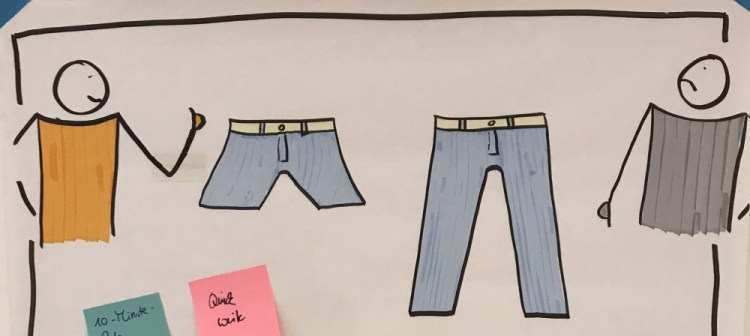
When Everything Is Suddenly Virtual
The last few weeks have been pretty tough on everyone. The new “normal” is quite different now in the training world, so we have a few ideas we want to share with you.
Here at Actineo Consulting, we pride ourselves on doing a job right. For example, the reason we use Training from the BACK of the Room (TBR) to design and deliver our courses is because cognitive science backs it up. We don’t deliver training through intuition or the notion of “It’s just the way it has always been done.” We look at cognitive science and what that tells us. We learn other ways of doing things and then apply them to our content.
In these times of lockdown, the easiest thing would have been to just change our courses to virtual delivery and create a 2-day “Zoom-Fest” with (insert online whiteboard tool du jour here). We decided that this would be a disservice to our attendees, our community, and ourselves. We decided to take a different approach.
Doing It Differently
We took a step back to learn the answer to the question, “What is the best way to deliver live virtual training?” To find an answer, we attended courses by experienced providers of live virtual courses, engaged with trainer communities, and looked at the available research. We came to the conclusion that a 2-day “Zoom-Fest” is not the way forward. Instead, we began redesigning our 2-day, face-to-face, in-person courses (wherever our license allowed us to). We have created virtual classes of 4 sessions, each approximately 2.5 hours in length including breaks. These sessions will spread over 5 days (Monday-Friday) with a rest day in between (Wednesday). As we learn more, we may change this. Why are we doing this? Because …
Shorter Trumps Longer Is More Important Than Ever Online
Some things translate straight from the TBR playbook – the importance of the 4Cs and the Six Trumps™, for instance. “Shorter trumps longer” becomes even more important when adapting a face-to-face class to online instruction.

There is significant disagreement in the academic community about what the ideal length of an online session should be. What we have discovered is that the model of in-person, face-to-face training doesn’t translate well to Live Virtual Classrooms (LVC) – or rather, what the research typically refers to as “Online Synchronous Teaching.”
We had to ask ourselves where the model of 8 hours in a training room came from in the first place. Our current thinking is that the rationale is based on several factors, which include the following:
- The venue is often only available by the day or half-day.
- Employers prefer to allow people out of the office for a fixed time period – it simplifies things.
- Trainers find it easier to book out a contiguous block of time.
- Logistically it is easier for attendees to find a short window to be out of office than many windows spread over a number of days.
- If the attendees are coming from out of town, minimizing the travel time and time away from home matters.
- Educational institutions have structured instruction this way for decades and businesses have followed suit.
- All this being said, our world has changed in ways we can’t possibly know right now, so we feel that it is time to think about a different tomorrow. If that tomorrow involves a lot of live virtual classes, then we have a duty as trainers to understand what that means for our learners.
What Does the Science Say?
By and large, academics suggest that synchronous online sessions should last no more than 2 hours. The range indicates that it is something more than 30 minutes but less than 2 hours. Industry experts also agree with this. For example, author Cindy Huggett states in her blog posts and articles that 8 hours of in-person, face-to-face training should not equal 8 consecutive hours in a synchronous online class. In her article Virtual Training Survey Reveals 2019 Trends and Surprises, Cindy points out that most successful, live, online sessions are 60 to 90 minutes long.
So, for now, our company will offer virtual classes comprised of 4 sessions of approximately 2.5 hours in length including breaks. We will spread these out over 5 days (Monday – Friday) with a rest day in between (Wednesday). We may change this as we learn more.
Six Trumps™ for Live, Virtual Classes
In tribute to Sharon Bowman’s Six Trumps™, we’ve come up with a set of “yes and” trumps for the virtual environment. We are applying these to our courses too. The six Virtual Trumps for live online classes are:
- Smaller trumps larger: We will keep class sizes to 12 attendees or fewer.
- Preparation trumps improvisation: We will always make sure that we have plans B and C in place, in case the technology breaks down during the class. In addition, we will introduce the attendees to the online class environment and tools before the class begins.
- Simple trumps complicated: We will always do the simplest possible thing with the simplest possible tools to meet the learning objective.
- Adaptation trumps replication: We will adapt our training to the strengths of an online class environment. We won’t fight against the limitations of the online space nor try to replicate an in-person class environment.
- Pairing trumps solo: We will always have someone in charge of production and technology in our online courses so that our trainers can focus on delivering the best virtual training experience for the learners.
- Off-line trumps lecture: We will create off-line homework/intersession work which will facilitate deeper learning and avoid the need for long lectures online.
We see these Six Virtual Trumps as a contract between us and our learners. They are a set of powerful commitments which we believe will help us deliver compelling, engaging and effective learning.
What’s Next?
We are continuing to do further research into these Six Virtual Trumps. We will be publishing follow-up posts with some of the science, industry practice, and thinking behind these as we find more. Keeping things empirical, we may also change them if what we find is that a “Virtual Trump” was based on a cognitive bias or intuition; so far, the science supports what we’ve written here. For the resources we used, please see the bibliography below our biographies. And stay safe during these uncertain times!